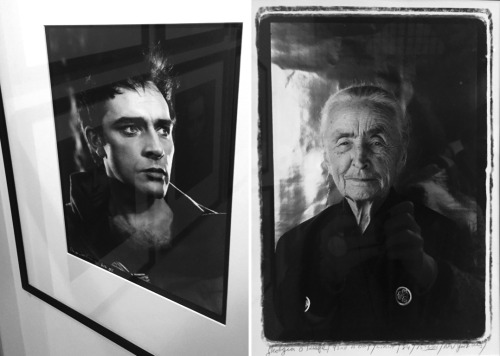Carla Sozzani began collecting photography in the early 70s, two decades before Paris Photo was a twinkle in anybody’s eye.
Sozzani didn’t think of photography as an investment, simply as a way of keeping “souvenirs” of her work and friends – which makes a lot of sense if your friends include Helmut Newton, Bruce Weber and Sarah Moon.

Starting her career in Italian fashion magazines towards the end of the 1960s, Sozzani went on to become editor of Vogue Italia’s special issues, working with everyone from Herb Ritts and Paolo Roversi to Deborah Turbeville and Robert Mapplethorpe. In the 80s she launched Italian Elle, where she commissioned everyone else – Nick Knight, Steven Meisel, Peter Lindbergh, Juergen Teller…
She founded Galleria Carla Sozzani at 10 Corso Como in Milan in 1990. “By the time I opened a gallery,” Sozzani told Vogue.com in a recent interview, “I’d been collecting for 20 years already. Some pictures’ meaning comes from memories and some because when you meet a photographer, when you spend time with an artist, when you hang the exhibition, you have this special relationship.”
Since opening, 10 Corso Como has hosted more than 250 exhibitions of design and photography. Artists, photographers and designers as diverse as Yayoi Kusama and Paul Strand, Marc Newson and Daido Moriyama, have been shown there, as have images from the World Press Photo Awards annually since the 1990s.

Above, a selection of Steven Meisel prints.
Entre l’Art et la Mode is not being exhibited in Sozzani’s own gallery, however, nor in her home town. Sozzani’s old friend and long-time fashion collaborator Azzedine Alaïa persuaded her to undertake the current show, for his space in the Marais, coinciding with Paris Photo 2016. The exhibition was curated by Fabrice Hergott, director of the Musée d’Art Moderne de la Ville de Paris.
Sozzani told Vogue.com: “Fabrice has a very sure eye. He curated everything. Actually, he and Azzedine did. I just let it go. I thought it better. I’m also curious to see how they see it. For me, everything has added meaning. I have a picture by Man Ray that has been with me forever… He didn’t choose it. I would have. So I’m happy that someone else has curated the show. It makes more sense. For me, it’s memories. He has another point of view.”

Above, a couple of Lindberghs and a lot of Urs Luthi.
The gap between what the images mean to Sozzani and to Hergott is tantalising, and leads one to speculate on how different the exhibition might have been if Sozzani herself had been the curator. Maybe a little less academic, a little more soulful. There certainly is a lot of wonderful stuff here, but a designer friend and I who wandered around it on Saturday evening felt it wasn’t 100% satisfying though we couldn’t quite put our fingers on why.

Above, Peter Lindbergh, “Le Touquet, Linda Spierings and Tatjana Patitz” (1987)
There are 198 prints on display, arranged in alphabetical order. This in itself is an unusual approach. The rhythm doesn’t quite click. It’s more like looking at an index than at a selection of images that were chosen because of how they speak to each other.
There are some extremely well-known images (Helmut Newton’s Charlotte Rampling, nude on the table at the Hotel Nord Pinus, Arles), and some real oddities (the smallest Richard Misrach in captivity, about the size of a dinner mat.)

Above, Richard Misrach, “Road Blockade and Pyramids” (1989)
As well, the images presented are not what one might expect from an exhibition with the word “Fashion” in its title. Swiss conceptualist Urs Luthi is represented by 20 prints, Peter Lindbergh by two. In fact, despite the title, there is very little that strictly qualifies as “fashion” photography. A more accurate description would be “photography by artists who are successful as fashion photographers.” And while it’s no reflection on the standard of work on display, there is a reason why great fashion photographers tend to do their most exciting work with great clothes as well as great models. Whether it’s Corinne Day shooting a teenage Kate Moss in skimpy knickers, or Cecil Beaton’s room of debutantes in Charles James ballgowns, the relationship between garment and wearer is central to an iconic fashion image.

Above, Angus McBean, “Richard Burton at the Old Vic in Shakespeare’s Coriolanus”(1958); Barry McKinley, “Georgia O’Keeffe’s 92nd Birthday” (1992)
However, to make up for the lack of fabulous frocks, there are plenty of less obvious pleasures – and treasures – on display. Bauhaus photographers Xanti Schawinsky and Eberhard Schrammen mix with David Seidner and Alfred Stieglitz. Barry McKinley’s portrait of Georgia O’Keeffe on her 92nd birthday is an absolute gem. And I loved seeing the great Scot Angus McBean in the middle of Paris. Interestingly, Hergott told Vogue.com, “I chose photos that surprised me and were new to me, like the work of Angus McBean, a fashion photographer who pushed into craziness.” So this exhibition is a learning experience for all of us, even for the curator.
“Entre L’Art et la Mode” is on November 11 – February 26, 2017. Galerie Azzedine Alaia, 18 Rue de la Verrerie, Paris 75004
© Fiona Hayes 2016
This article originally appeared on http://somethingimworkingon.tumblr.com



In spite of his Scottish-sounding name, Angus McBean was actually Welsh, born and educated in Monmouth and Newport. The National Library of Wales in Aberystwyth recently acquired his studio signature books, with the autographs of the many twentieth-century celebrities that he made portraits of, from Marlene Dietrich to the Beatles. They also have examples of his photo collages, some of which could certainly be described as “craziness”.